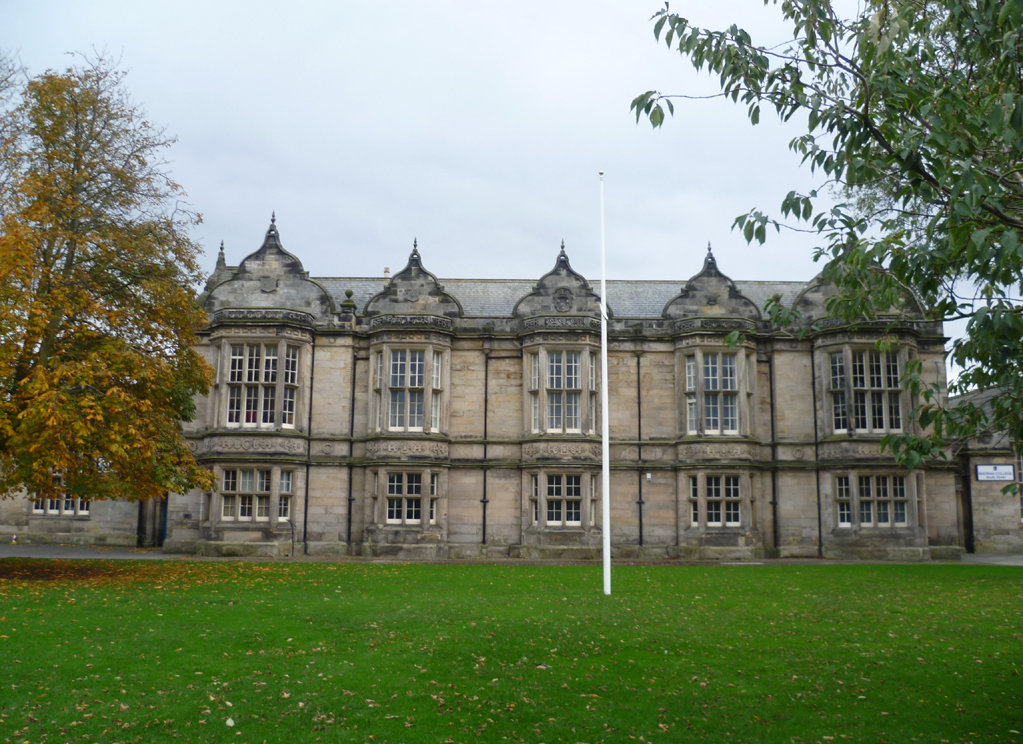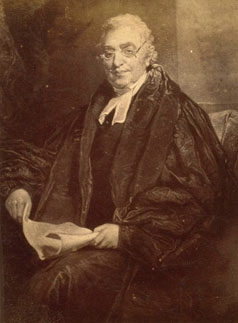A 19th Century Educationist
Dr. Andrew Bell’s Madras System
A Forgotten Reformer
From a Correspondent
The Rev. C.J. Lyon, in his History of St Andrews, published in 1834, devotes his last chapter to the then new Madras College. Just touching and no more on his misgivings as to the possible over-extension of educational facilities to the masses, he goes on to expatiate on “the mutability of human affairs and human opinions.”
The new college had been built on the site of a Dominican monastery, and the historian reminds his contemporaries that, just as the great medieval religious institutions have been swept away by generations impervious to the old ideas, so ages may follow that will sweep away the schools of the 19th Century.
Such a semi-prophecy seems far from fulfilment, yet one can imagine the spirit of Andrew Bell, M.D., D.D., hovering, morosely uneasy, over St Andrews on October 1st, when the centenary of Madras College will be celebrated. The school has triumphantly survived the vicissitudes of a hundred years, but the educational principles it was to perpetuate and the personal fame to which the founder was by no means indifferent have alike vanished from the general memory of man.
In praise of Andrew Bell
However forgotten Andrew Bell may be to-day, there were many (and some whose opinions were valuable) at the beginnning of last century, who had no doubts of his greatness.
Southey coupled him with Thomas Clarkson as “the two greatest benefactors of the human race who have appeared since Martin Luther,” and Coleridge wrote to him, “Oh, dear Dr Bell, you are a great man!” adding the assurance that, “While I have life and power, I shall find a deep consolation in being your zealous apostle.”
Wordsworth was almost as 2complimentary, though less picturesquely quotable. The young Hartley Coleridge and three young Wordsworths were entrusted to the doctor’s great system. Both Archbishops, the Lord Chancellor, the Speaker, all were his supporters. Prinny approved. And, keeping the best for the end of the paragraph, here is the dictum of Mr Justice Park – “(Dr Bell’s) plan is one of the most stupendous engines that ever have been wielded, since the days of our Saviour and His apostles, for the advancement of God’s true religion upon earth.”

Madras College, the original building in South Street, St. Andrews, Scotland.
A chequered career
Andrew Bell was born in St Andrews on March 27, 1753. His father, Baillie Bell, was a wig maker with a strong bent towards natural philosophy, in which study, as in mathematics, Andrew distinguished himself at the University of his native city.
Having his way to make in this world, he emigrated to America, where he spent seven years (1774-1781) as a private tutor at West Point, Virginia. The place and the dates stir the imagination, but nothing is known of his reactions to the war. One fact, however, is clear. He already possessed his mysterious talent for making money. Though his salary was paid, as his more readable biographer tells us, “sometimes in money, sometimes in tobacco, and sometimes not at all”, he returned to Scotland in 1781 with between £800 and £900.
Duel ends in comedy
Soon after his homecoming he displayed the combativeness so marked in later life. He and a Mr. Crookenden met, a stone’s throw from the Old Course, to settle with pistols some unexplained quarrel. Bell’s agitation and myopia combined to bring about a strange end to the affair; the signal being given, he wheeled about and discharged his fire, not at his antogonist, but at his own seconds. Amazed but unhurt, they gave way to their amusement; laughter proved infectious, and the duellists, olim hostes nuno fratres, dined together amicably.
Bell spent a year or two in private tuition; then, turning his thoughts towards Holy Orders, he went with an introduction from a friend (son of the great Bishop Berkeley) to the Bishop of Carlisle, who ordained him. A curacy in Leith followed, but his restless energy drove him further afield, and in February, 1787, he sailed for Calcutta with the intention of lecturing on natural philosophy and picking up what he could in the way of private turoring. He sailed as Doctor Bell, his Alma Mater declining to bestow on him the LL.D. Degree that he wanted, but cheerfully granting its M.D. to one who had never studied medicine.
The turning point
He never reached Calcutta. His ship touched at Madras, where a military male orphan asylum was in the process of formation. This institution he was invited to superintend. His acceptance of this invitation was the turning poiint in his career, for the work appealed to him and he was at his best in the next few years.
Refusing the salary offered him, he threw himself into his task as a labour of love. But his self-devotion went not unrewarded. Chaplainships to various regiments, bringing money and practically no duties, fell upon him; and, much more important, at Madras he hit upon his system. “Hit upon” is the phrase, for his “discovery”, as he always called it, was of an accidental nature.
Discovery of the System
It would seem that he had early and rightly formed a poor opinion of his teaching staff, a body of men both inefficient and ill-disposed to their work. Then one day, riding past an open-air native school , he saw the younger children writing with their fingers on sand strewn on the ground before them. Struck by this method, which had both Scriptural sanction and the possibility of success, he gave orders that it was to be adopted forthwith in the asylum.
The usher of the lower classes flatly condemned it as a pedagogic impossibility. Bell, disgusted by such recalcitrance, impulsively put a little boy called Johnnie Frisken in charge of the beginners. And here was born the Madras or monitorial system of teaching. Johnnie’s success was so complete that one by one the masters found themselves standing by while a number of small boys taught all the classes of the school. Not only did the pupils advance by leaps and bounds along the paths of learning, but the moral tone of the school was immeasurably nobler and sweeter than before. By the time young Frisken was eleven he had a third of the school under his care, and there was no slackening in the rate of progress, intellectual and moral.
Return to Scotland

Dr. Andrew Bell. |
For health reasons Dr Bell left India in 1796, bringing with him his great idea and the sum of £25,935 16s 5d. (His accounts seemed to have been well kept.) Home again, he became a landowner in Galloway and published his report on the Madras Asylum, copies of which were circulated among the Lords, spiritual and temporal. The first practical response came in 1796, when his system was introduced in St Botolph’s Parochial School, London.The next active proselyte was apparently Dr. Briggs, Mayor of Kendal.
Then, in 1801, Bell became Rector of Swanage and was in a position to advise and even dominate the schoolmasters of the district. As a result, there were soon thirteen day-schools and three Sunday schools in this part of Dorsetshire, all exemplifying the benefits of the Madras method.
The villain of the story
At this juncture there entered, from Bell’s point of view, the villain of the story. One of his earliest converts had been a youth of 18, Joseph Lancaster, who had opened a little school in his father’s house at Deptford. At first, he had been duly deferential; in 1804 he wrote asking for advice and an interview; in 1805 they met.
But it was soon obvious that the relations of prophet and disciple were impossible to the two men Bell was a pillar of the Church of England; Lancaster was a Quaker. Bell had cautious views on the subject of educating people above their station in life; Lancaster was much less safe on this point. Bell believed that nothing was needed in the training of a teacher but experience; Lancaster laid stress on a grounding in psychology.
Recriminations began, chiefly instigated by a Mrs Trimmer, a sort of Anglican she-dragon who might have sat as a model to Anthony Trollope. Finally, in 1807, Lancaster claimed in a newspaper advertisement to have “invented” a system which sounded indistinguishable from Dr Bell’s. He asserted, among other things, that under this system “Any boy who can read can teach arithmetic with the certainty of a mathematician, although he knows nothing about it himself.”
Extension of the System
Partisanship achieved more than merit alone would have done. Loyal sons and daughters of the Church rallied to Bell’s standard. The result was a more and more rapid extension of his system, and the ultimate foundation in 1811 of “The National Society for Promoting the Education of the Poor in the Principles of the Established Church throughout England and Wales.” The list of office-bearers bristled with episcopal and feudal titles. By 1812 the Society was educating 8620 children in 52 schools; in 1813 the children numbered 40,484 and the schools 230.
Gift to St. Andrews
The National Society did not concern itself with Scotland, but Dr Bell had not forgotten his native town. He interested himself in the English School of St Andrews where the master David Crichton, put the Madras principles into operation, and in 1831 suddently, perhaps impulsively, trans-
ferred stocks to the value of £120,000 to four trustees in St Andrews.
He had less than a year to live, and this short time was spent mainly in quarrelling with the men to whom he had entrusted his money. After much wrangling and many threats of lawsuits, the money was divided into 12 parts, five of which were to be devoted to the erection and endowment of a school in St Andrews, where the Madras System of Mutual Instruction should be a permanent model for the world to follow. The foundation stone was laid in April 1833, by which time the founder (by virtue of his prebendal stall, one fears, and not his services to education) had been interred in the Abbey, and Madras College was in due course opened on October 1st.
A pathetic sequel

The memorial to
Dr. Andrew Bell
at Westminster Abbey. |
The sequel to all this enthusiasm is pathetic – what a cinema-nurtured generation may best describe as a “fade out”. The paternal features of Dr Bell look down still, as they have done through a hundred years, on the pupils of Madras College, but a study of the school history reveals that, though many characteristic features have been tenaciously maintained, the corner-stone of the temples was allowed from the beginning to moulder quietly away. Nowhere today is the once-vaunted system in operation.
Yet we might profitably spare a thought for the man who, when trained teachers were almost non-existent and when public money was unavailable for education, enabled thousands to attain some kind of learning who otherwise must have remained illiterate.
|

